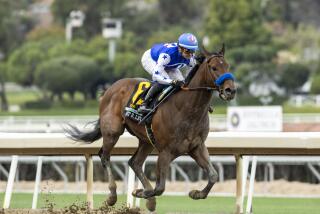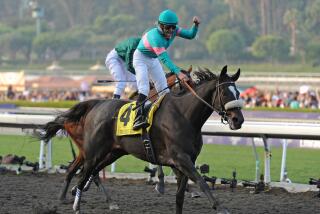Column: Doug O’Neill’s suspension shows why little makes sense in horse racing

Horse racing is the only sport where its customers are best served by putting on blinders.
It isn’t always a mess. Just most of the time.
We have gone through a 2014 Triple Crown season where a potentially beautiful story of California Chrome, a beloved trainer and a couple of first-time owners turned beastly at the Belmont Stakes. There, the horse didn’t win and one of the owners lost his common sense.
The Breeders’ Cup is 10 days away. It is a two-day spectacular, held for the third consecutive year at beautiful Santa Anita. The Breeders’ Cup generally overcharges the public, but also generally delivers. This year, two of its biggest stars, Wise Dan and Beholder, are out because of injuries. Assume ticket prices won’t go down.
Now, to top it off, we have Doug O’Neill saga, Part 2.
O’Neill is the Southern California trainer who guided I’ll Have Another to the first two legs of the Triple Crown in 2012, then scratched the horse the day before the Belmont because of a tendon injury. He served suspension time after that for a milkshake violation (giving a horse excessive carbon dioxide) in August 2010. He denied guilt.
Now, he is serving more hard time.
Because of the discovery of a drug called Oxazepam in a horse named Wind of Bosphorus at Belmont Park in June 2013, O’Neill will not be able to be the trainer of record for any entrants in the Breeders’ Cup. One of his horses, Goldencents, is defending champion in the Dirt Mile.
When hit with the most recent violation, O’Neill tried to negotiate a suspension that would start after the Breeders’ Cup. But then, the Breeders’ Cup invoked its “convicted trainer rule,” and exiled O’Neill to some sports bar in Santa Monica to watch. No word on whether he will wear prison stripes.
The O’Neill case is just another example of why Lakers exhibition games can make the sports front page and horse racing doesn’t.
What’s the deal? What is the ticket-buying, $2 gambler to think? Is O’Neill Jeckyll, or is he Hyde? A sinner or a saint?
Should we be proud of racing for taking a firm stance, even if it always invokes its punishments months and years after the crime? Does racing use test labs in Antarctica?
Or should we be questioning why, and how, horse racing has made a post office poster boy out of O’Neill, who, by most accounts, and by personal experience, is a decent, hard-working, fun-loving guy?
Like much of what happens in racing, with its alphabet soup governing boards (CHRB, TOC, CTT, etc., in California alone), little is clear and little makes sense.
O’Neill’s 2010 violation was from a horse named Argenta, who was lucky to make it around the track. Argenta, off at 20-1, finished sixth of eight horses in that race. Argenta didn’t need to be milkshaked, he needed rocket boosters.
In the 2013 violation in New York, Wind of Bosphorus was transferred to three different stalls in the days before the gelding ran. O’Neill, who wasn’t in New York when the horse ran, said he had to look up Oxazepam and learned it was mostly used by people with irritable bowel syndrome or by recovering alcoholics.
It is also used as a calming medication, and that might help a horse. Why would it be on racing’s Class-2 banned list if it had no enhancement qualities?
Fans who want to care about racing, who want to go to the track and put down a few bucks without having to be chemists or conspiracy theorists, will soon just start throwing up their hands and finding a water polo game.
O’Neill is the kind of person with whom you want to have dinner — funny, smart, charming. He spent the entire 2012 Triple Crown season answering, with incredible patience and good humor, the same media questions, each phrased slightly different but all basically the same query: “Why do you cheat?”
Before that 2012 Belmont, and before he scratched I’ll Have Another, the New York Racing Assn. ordered all Belmont Stakes horses stabled in a detention barn. At whom do you suppose that was aimed?
In the midst of all this, O’Neill allowed himself to be roasted at a charity event. One roaster, Tim Conway Jr., delivered the classic blow: “Most horses, when they are done, go out to pasture. Doug’s go to the Betty Ford Center.”
Would a bad guy, a cheater, smile through all this? Is he the Lance Armstrong of horse racing or a wronged Peyton Manning? Or is he the greatest con artist since Paul Newman in “The Sting.”
One race official summed it up thusly: “I love Doug O’Neill, but how many times can you say the dog ate the homework?”
According to a 2011 article in HBPA.com, the website for the Horsemen’s Benevolent and Protective Assn., thoroughbred racing in the U.S. had 38 jurisdictions, each with its regulatory agency. There are 18 racing test labs, six accredited. Is one of those that Antarctica lab that takes six months to find a test tube?
In essence, horse racing in the U.S. is a sport in which everybody is in charge. And nobody. You can laugh about the travails of Roger Goodell or Bud Selig, but at least you know at whom to laugh.
Hate Doug O’Neill or feel sorry for him. Just don’t try to figure out his sport. Don’t question why they never penalize the vets, why there aren’t security cameras in every stall, why every major decision takes 10 months and 80 meetings and then can be negotiated.
Don’t question why a suspended O’Neill is allowed to work out a deal with his assistant, Leandro Mora, to share in any Breeders’ Cup winnings.
Just put on your blinders and come on out.
More to Read
Get our high school sports newsletter
Prep Rally is devoted to the SoCal high school sports experience, bringing you scores, stories and a behind-the-scenes look at what makes prep sports so popular.
You may occasionally receive promotional content from the Los Angeles Times.







